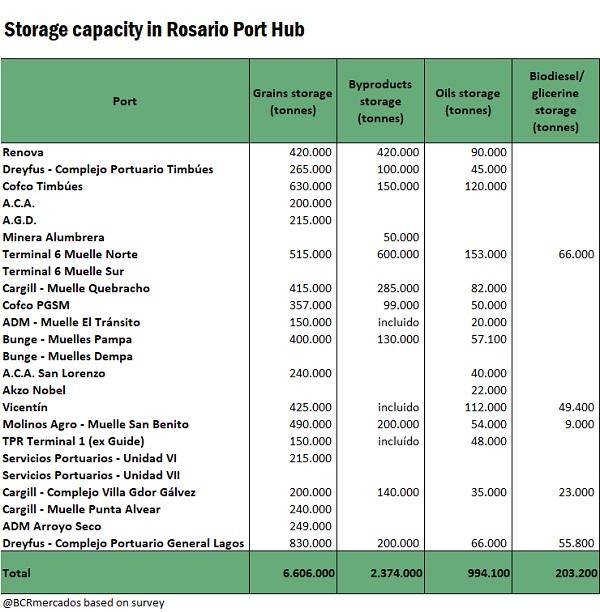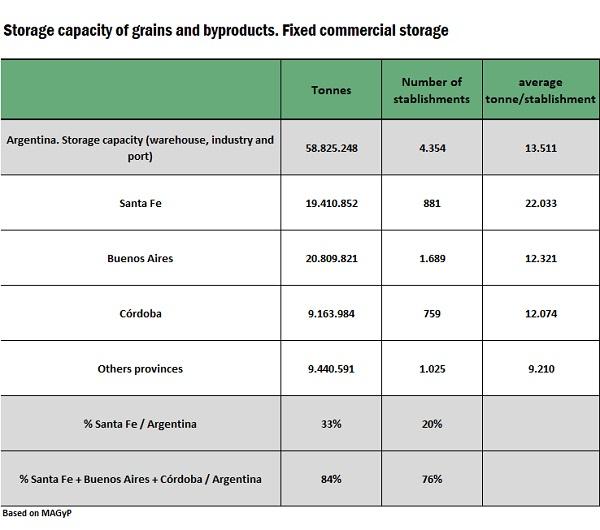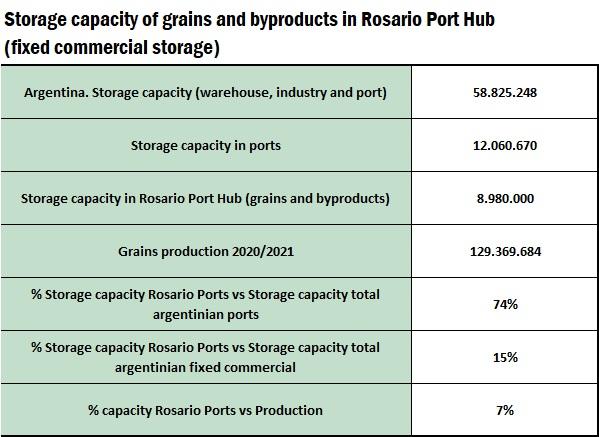15% of the fixed commercial storage capacity in Argentina and 74% of the storage capacity in the country's ports are located in the terminals of Rosario export hub
Based on a new survey carried out by the Department of Information and Economic Studies of the Rosario Board of Trade of the port terminals and plants of Rosario, the most important characteristics of the infrastructure of the area were reviewed -in a series of articles published in our weekly report- for receiving, processing and dispatching grains, seeds and by-products. This allowed us to dimension the relative importance of the area that we call Rosario export hub as the main agribusiness pole of the country, and one of the most important in the world. In this article, we will advance in this characterization of the port node, and we will focus on a fundamental aspect for terminals, which is the storage capacity of grains and its by-products.
Along the 70 km of coast on the Paraná river that go from the town of Timbúes to Arroyo Seco, called the Rosario city agribusiness node, a total of twenty-nine (29) port terminals operating different types of load can be found. The majority of these terminals (twenty-two, to be precise) are equipped for loading grain, oil and/or by-products. Also, 12 of these terminals have oilseed processing facilities.
In this framework, due to the large influx of goods that these terminals must concentrate for their work, and consistent with the seasonality of the agricultural activity and the entry of goods to port, as well as the difference that this may have with the seasonality of industrialization, loading and shipping of vessels overseas, companies must have adequate facilities that allow them to store and maintain in good conditions the goods that are waiting to be industrialized or exported.
According to our latest survey, Rosario port terminals, with their annexed factories, have a theoretical capacity to store (in silos or fixed structures) 6,606,000 tons of grain. In turn, the by-product storage capacity amounts to 2,374,000 tons, where meal and pellets are mainly stored. Finally, the terminals also have the capacity to store 994,100 tons of oil, and have facilities to store 203,200 tons of biodiesel or glycerine.
Of the terminals surveyed, those with the greatest physical storage capacity for cereals and oilseeds are:
In the Northern area of Rosario, the COFCO terminal in Timbúes stands out, with a storage capacity of 630,000 tons of grain. It is followed by the port-plant of Terminal 6, with facilities for storing 515,000 tons of grain. This plant also has the largest oil storage capacity in the Up-River Paraná ports, with infrastructure to store 153,000 tons of oil. The podium for the Northern area is closed by the Molinos Agro plant in San Lorenzo, Muelle San Benito, which has a storage capacity of 490,000 tons of grain.
In the South, the General Lagos port complex, owned by LDC, is at the top with a storage capacity of 830,000 tons of grain, being the plant with the largest grain storage capacity in the entire Up-River. It is followed in importance in the area by the ADM terminal in Arroyo Seco, where about 250,000 tons of cereals can be stored.
Dimension of Rosario export node in the national storage infrastructure
According to information released by the Argentinian Ministry of Agriculture, Livestock and Fisheries (MAGyP, for its Spanish acronym), port terminals in Argentina have a storage capacity of 12,060,670 tons of solid products, and 1,129,600 tons of liquids. In this sense, we are in a position to affirm that the solid storage infrastructure in Rosario terminals, a total of 8,980,000 tons between grain and by-products, represents 73% of the total solid storage capacity of the port terminals of the country.
Port terminals and oil factories are not the only commercial units with the capacity to store agricultural products. Throughout the country, there are more than 4,354 establishments capable of fulfilling this task. The grain collection plants in Argentina can be basically classified into three types (MAGyP, 2020):
-Private collection centres organized as commercial companies and first and second grade cooperatives.
-Storage establishments of lifting facilities for loading grain for export.
-Storage in industrial facilities with the aim of transforming grains into meals, oils, alcohols, biofuels and by-products.
In total, the commercial fixed storage capacity in Argentina is estimated in 58,825,248 tons. This estimate includes the capacity of silos or fixed structures of all the storage plants, industries and port warehouses throughout the country. The temporary warehouses annexed to those plants have also been included.
The province of Santa Fe is the second in the country in terms of number of facilities qualified for this task, while also occupying the second place in terms of total storage capacity. The province has 881 establishments for the collection of cereals, with a total storage capacity of 19,410,852 tons. It currently concentrates virtually a third of the commercial fixed storage capacity of the country. Among the three main producing provinces at a national level, Buenos Aires, Santa Fe and Córdoba concentrate 84% of the total storage capacity of the country.
Now we can go further in our analysis by estimating the share of Rosario port node, not only in terms of the merchandise storage capacity of the country's port terminals, but also in the total storage capacity in commercial fixed structures nationwide. We need to make clear we are not considering the fixed silos in the farmers' fields, about which there is no precise information from public offices, nor the storage capacity in silo-bags owned by farmers.
The ports and factories of Rosario export node represent 15% of the total storage in fixed commercial structures nationwide, considering the storage of solids. Taking into account the estimated amount produced in crop 2020/21 of the main cereals and oilseeds in our country (129 Mt), the storage infrastructure of the agribusiness pole could have housed 7% of the total domestic production.


